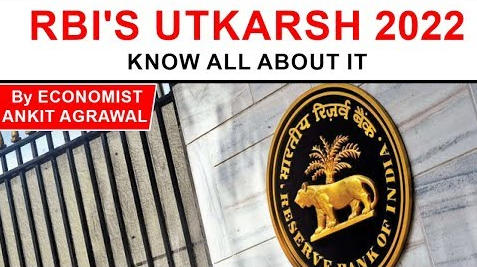Table of Contents
Q) The Reserve Bank of India (RBI) acts as a bankers’ bank. This would imply which of the following? (UPSC 2012)
- Other banks retain their deposits with the RBI.
- The RBI lends funds to the commercial banks in times of need.
- The RBI advises the commercial banks on monetary matters.
Select the correct answer using the codes given below :
(a) 2 and 3 only
(b) 1 and 2 only
(c) 1 and 3 only
(d) 1, 2 and 3
Q) The Reserve Bank of India regulates the commercial banks in matters of (UPSC 2013)
- liquidity of assets
- branch expansion
- merger of banks
- winding-up of banks
Select the correct answer using the codes given below.
(a) 1 and 4 only
(b) 2, 3 and 4 only
(c) 1, 2 and 3 only
(d) 1, 2, 3 and 4

WHAT IS ‘UTKARSH 2022?’
- It is a 3 year medium term roadmap to improve regulation and supervision by RBI.
- It is in line with the global central banks’ plan to strengthen the regulatory and supervisory mechanism.
- An internal committee was formed, which was anchored by Deputy Governor Viral Acharya, to identify issues that needed to be addressed over the next three years.
- A dozen areas were identified by the committee.
- The main idea is that the central bank plays a proactive role and takes preemptive action to avoid any crisis like the IL&FS debt default issue and the crisis of confidence the non-banking financial sector faced in the aftermath.
HISTORICAL PERSPECTIVE
- The Reserve Bank regulates and supervises the major part of the financial system.
- The bank failures of the mid-1930s brought forth the necessity of regulation of banking system.
- The nationalisation of fourteen major commercial banks in 1969 was a turning point in the Indian banking system with the entry of the public sector.
- To strengthen the supervisory mechanism further, it was decided to institute a new type of inspection during 1977-78, viz., Annual Appraisal of banks in addition to the Financial Appraisal.
- The decade of the 1990s was a watershed in the history of the Indian financial system.
- Narasimham Committee, 1991, 1998.
- Apart from on-site inspections, the Reserve Bank has adopted other three supervisory approaches, viz., off-site monitoring, internal control system in banks and use of external auditors.
- Since 1995, all financial institutions in India are being covered by an on-site supervisory process CAMELS standards (capital adequacy, assets management, earnings, liquidity, systems and procedures).
- In November 2004, the Reserve Bank revised the guidelines on ‘Know Your Customer’ (KYC) principles in line with the recommendations made by the Financial Action Task Force (FATF) on standards for Anti-Money Laundering (AML) and Combating Financing of Terrorism (CFT).

RECENT DEVELOPMENTS
- RBI in process of making financial sector fully compliant with BASEL 3 norms.
- The regulatory powers of the Reserve Bank of India have been significantly enhanced, with Budget 2019-20 bringing housing finance companies (HFCs) under its ambit and deepening its governance of non-banking finance companies (NBFCs).
NBFC CRISIS

- Founded in 1987.
- IL&FS Ltd, or Infrastructure Leasing & Finance Services, is a core investment company and serves as the holding company of the IL&FS Group.
- It has institutional shareholders including SBI (6.42%), LIC (25.34%), ORIX Corporation of Japan and Abu Dhabi Investment Authority (ADIA).
SO WHAT IS THE CRISIS?
- IL&FS defaulted on a few payments and failed to service its commercial papers (CP) on due date. • This means the company has run out of cash or it is facing a liquidity crunch.
- Consequently rating agency ICRA downgraded the ratings.
- The defaults also jeopardised hundreds of investors, banks and mutual funds associated with IL&FS.
- The defaults sparked panic among equity investors.
REASONS BEHIND THE CRISIS
- A major reason behind troubles of IL&FS is complications in land acquisition.
- The 2013 land acquisition law made many of its projects unviable.
- Negligence in auditing done by “big three”—EY, Deloitte and KPMG.
Q) The Reserve Bank of India (RBI) acts as a bankers’ bank. This would imply which of the following? (UPSC 2012)
- Other banks retain their deposits with the RBI.
- The RBI lends funds to the commercial banks in times of need.
- The RBI advises the commercial banks on monetary matters.
Select the correct answer using the codes given below :
(a) 2 and 3 only
(b) 1 and 2 only
(c) 1 and 3 only
(d) 1, 2 and 3
Q) The Reserve Bank of India regulates the commercial banks in matters of (UPSC 2013)
- liquidity of assets
- branch expansion
- merger of banks
- winding-up of banks
Select the correct answer using the codes given below.
(a) 1 and 4 only
(b) 2, 3 and 4 only
(c) 1, 2 and 3 only
(d) 1, 2, 3 and 4
Latest Burning Issues | Free PDF






















 WhatsApp
WhatsApp